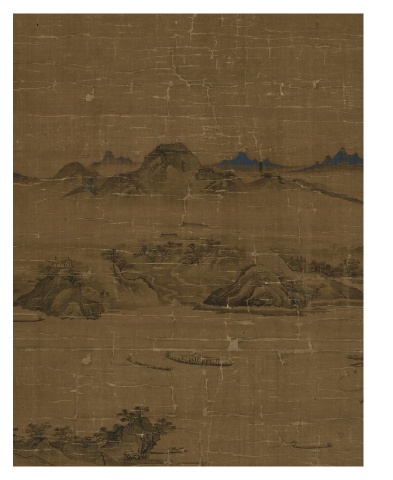Page 439 - japanese and korean art Utterberg Collection Christie's March 22 2022
P. 439
While 16th century paintings of literati gatherings tend to idealize trees, and pavilions enveloped in mist add a poetic dimensions to
the landscape, Gathering of Scholars at the National Library the serenity of this riverscape. The latter painting includes larger
depicts the actual scenery of the event in 1531. The National architectural elements that occupy a greater proportion of the
Library was located at a scenic site on the shore of the Eastern Lake picture, resulting in a close-up view of the National Library and
(Dongho) of the Han River. It was constructed near Dumopo, its immediate backdrop landscape. This painting focuses on details
the confluence of Jungnang Stream and the Han River, in 1517. of human interest – figures engaging in a conversation within the
Gathering of Scholars att the National Library shows a panorama building, climbing the mountain along a well-trodden path, and
of the Eastern Lake (currently Oksu-dong) as seen from across the arriving on horseback. The architectural structure is rendered in
river (Apgujeong-dong). This follows the typical style of landscape as much detail as the trees. Despite minor changes in perspective
painting that thrived in the early 16th century. An Gyeon’s style, and composition, these three 16th century paintings commonly
which recalls the stylized Li-Guo style of the Yuan dynasty, is share pictorial elements inherited from An Gyeon style. The
found in this painting. The tripartite composition features rocky compositional features, the ample use of short lines and spots, a
hhills in the foreground topped by trees rendered with washes and sharp contrast between the dark and light of these paintings are
short liner strokes, an expansive middle ground with a single boat defining elements of 16th-century Joseon landscape painting. These
moored at the shore, and a distant building complex emerging stylistic features are also found in other representatives 16th-century
from the mist. The surface of the Mount Eungbong shows short, landscape, including Eight Views of the Xiao and Xiang Rivers
repeated texture strokes, known as danseon jeomjun; a stylistic attributed to An Gyeon (National Museum of Korea), and Eight
elements that appeared in Joseon landscape paintings only after Views of the Xiao and Xiang Rivers in the collection of Daigan-ji
the late 15th century. The repeated short lines form a contrast in Hiroshima Prefecture, Japan (before 1539).
between light and dark, which is a distinctive feature of early Joseon
painting. The lower part of the work lists the names of the twelve
participants in order of ranks: Jang Ok (張玉), Hong Seoju (洪
The fog surrounding the pavilions, thatched houses, and villages 敍疇), Heo Ja (許磁), Im Baekryeong (林百齡), Song Insu (宋
evokes a poetic atmosphere. The use of vapors and mists, 麟壽), Song Sun (宋純), Ju Sebung (周世鵬), Yi Rim (李霖),
spatial arrangement, and diverse brushstrokes together create a Heo Hang (許沆), Sin Seokgan (申石潤), Eum Eun (嚴昕), and
compositional coherence and sense of expansiveness. Scholars clad Choe Yeon (崔演). This gathering is assumed to have been held
in official hats and garments are shown enjoying wine in a boat sometime between the third month of the lunar year of 1531, when
beneath a canopy. Nearby, another boat carries two more jars of Heo Hang was appointed to the fourth censor of the Office of the
wine. A few fishing boats and fishermen hauling in a net in the Censor-General, and the fifth month of the that year, when Choe
river add small, intriguing vignettes of Joseon life. The figures and Yeon was promoted to the sixth counselor in the Office of Special
actual scene of the gathering are depicted in diminutive size, despite Advisors.
their significance. The architecture of the National Library is nestled
in mist, and only the peaks of the roofs can be seen. Beyond Mount This painting was formerly owned by Kanda Kiichiro (1897–1984),
Eungbong, the bluish silhouettes of Mounts Bukak and Samgak can a famous Japanese sinologist and scholar of bibliography. As a
be recognized. The most discernable feature of this painting, the use student of Naito Konnan (1866–1934) and a youthful member
of short-line texture strokes, also appears throughout the mountains, of the Kyoto school of Sinology, Kanda devoted himself to
hills, and rocks of the midground and far distance. The oddly promoting Eastern art and preserving national character. While
shaped rocks and hills are delineated with trembling contours, while serving as a professor at Otani University and director of Kyoto
their surface is represented with many short, repeated texture strokes National Museum, Kanda Kiichiro published extensively on the
along with ink washes off various tones. caves at Dunhuang, landscape painting, and calligraphy from China
and Japan. The collector’s mark, reading “Kanda no. 68,” is still
Two other paintings of scholars’ gatherings at the National attached to the wooden container of the scroll.
Library in the 16th century survive today – one in the collection
of Gwangju National Museum (ca. 1545) and the other in Seoul In short, this scroll from the early 16th century is one of the
National University Museum (ca. 1570). The former, entitled first paintings to depict the actual setting of a scholars’ gathering.
Scholars’ Gatherings at the Eastern Lake, presents a symmetrical Moreover, this stunning work attests to enduring influence from the
arrangement of pictorial elements in the foreground and far An Gyeon style throughout the first half the Joseon dynasty.
distance, separated by a vast watery expanse. Mountains, hills, cliffs,
Yoonjung Seo
Myongji University, Seoul

